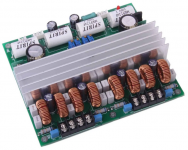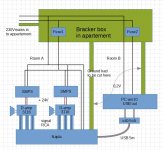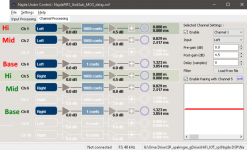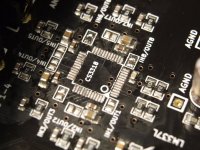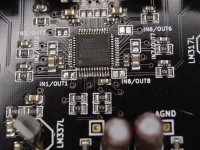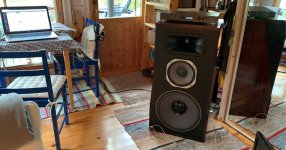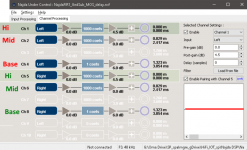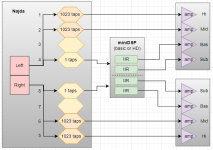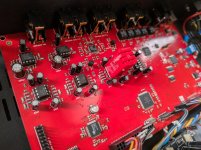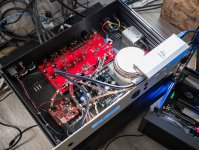Analyzing CS3318 datasheet I found info that max output capacitance is 100pF. Above that it can gat unstable or needs additional output/buffer stage that can drive higher capacitance.
Maybe that is your issue, long or hi capacitance IC's.
I have made +2,5 m 4 channel RCA cables between Najda and my amplifiers. Maybe this is my problem. I did try to make short speaker cables and did integrate the amplifiers with the speakers.
I have two of these 4channal amplifier boards.
All power connectors are on one power socket "stripe".
I know about ground loops and other similar problems from working with PA systems. You can never predict loops, there are just best practice rules. I'm attaching a drawing that I sent to Nick when we discussed possible problems in my setup. The picture does not represent my current setup but shows how problematic it can get.
Attachments
While I was checking "ground" wire connection in najda box, it was not connected to najda signal/pcb ground so there should be no need to cut it.
Question is it if those SMPSes for amps don't do this connection.
Also you can use galvanic isolation interface for USB, usually small box that can be connected in between devices. This should get rid of of this potential difference.
Something like that or simmilar
USB2.0 1500V ADuM3160 USB To USB Isolator Audio Signal Power Supply Isolation | eBay
As for IC look for some low capacitance cables. Not sure what you can find in your neighborhood. Lately I was looking on Neotech KM-6003 which has 39pF/m (remember that rca plugs and sockets have some capacitance too).
You can search trough microphone cables with low capacitance.
Question is it if those SMPSes for amps don't do this connection.
Also you can use galvanic isolation interface for USB, usually small box that can be connected in between devices. This should get rid of of this potential difference.
Something like that or simmilar
USB2.0 1500V ADuM3160 USB To USB Isolator Audio Signal Power Supply Isolation | eBay
As for IC look for some low capacitance cables. Not sure what you can find in your neighborhood. Lately I was looking on Neotech KM-6003 which has 39pF/m (remember that rca plugs and sockets have some capacitance too).
You can search trough microphone cables with low capacitance.
Last edited:
I noticed two different problems on Najda used with FIRs, or more precisely when the DSP performs a lot of computation or above 50% activity on the 2 coprocessors.
problem 1: random phase shift between channels with FIR files having the same samples.
problem 2: distortions in the upper midrange / treble perfectly audible, which appears after several switching on and off of Najda, without ever modifying anything in the configuration of the filters ... This distortion can disappear by "magic" after a change of filter file in the NUC ...
These problems appear on the basic version of NAJDA with FIRs, and also continue in I2S input and output use, so the only common active element remains the DSP, which must be the source of the problems, when it manages a very large amount of calculation.
The power regulators do not seem to me to be the cause, Nicolas very well decoupled the various active circuits of Najda, and perfectly separated the masses of the digital and analog stages. I know these problems quite well because I come from the world of Radio-Frequencies.
I think these are issues related to the computing power installed in the DSP, and how to deal with it with software (I'm not a developer!) Which creates random instabilities.
Despite everything, it is undeniable that Najda remains a very interesting solution for lucky DIY enthusiasts, who are lucky enough to still own one or more, because it is possible to experiment a lot, there is a replacement for the " great "Precision Analogue solution, but it is not the same budget!
problem 1: random phase shift between channels with FIR files having the same samples.
problem 2: distortions in the upper midrange / treble perfectly audible, which appears after several switching on and off of Najda, without ever modifying anything in the configuration of the filters ... This distortion can disappear by "magic" after a change of filter file in the NUC ...
These problems appear on the basic version of NAJDA with FIRs, and also continue in I2S input and output use, so the only common active element remains the DSP, which must be the source of the problems, when it manages a very large amount of calculation.
The power regulators do not seem to me to be the cause, Nicolas very well decoupled the various active circuits of Najda, and perfectly separated the masses of the digital and analog stages. I know these problems quite well because I come from the world of Radio-Frequencies.
I think these are issues related to the computing power installed in the DSP, and how to deal with it with software (I'm not a developer!) Which creates random instabilities.
Despite everything, it is undeniable that Najda remains a very interesting solution for lucky DIY enthusiasts, who are lucky enough to still own one or more, because it is possible to experiment a lot, there is a replacement for the " great "Precision Analogue solution, but it is not the same budget!
problem 2: distortions in the upper midrange / treble perfectly audible, which appears after several switching on and off of Najda, without ever modifying anything in the configuration of the filters ... This distortion can disappear by "magic" after a change of filter file in the NUC ...
This is the kind of behavior that I tried to describe earlier in post #3619.
I have tried to minimize the load Najda has to deal with so here is my solution:
I use channels 1, 2, 5 and 6 with FIR 1000 coefs. These are Hi and Mid drivers channels.
I also use channels 4 and 8 for the base region with 1 coefs witch is a passthrough filter.
I do the base EQ with a MiniDSP. Two 15" base and two 12" subs.
I did try to disable different channels one-time when I got distortion similar to what Trucqui gratte described.
I noticed that the distortion was on channel2. The distortion disappeared when I disabled channel 1.
Attachments
Have anyone compared these two scenarios:
1) FIR filters implemented into the Najda DSP
2) IIR filters running on Najda and getting the signal pre-linearized with convolution file over the output y the PC in advance
This will have the possibility to have much more precise control over the filters and Najda will work with less effort in a higher internal sample rate.
1) FIR filters implemented into the Najda DSP
2) IIR filters running on Najda and getting the signal pre-linearized with convolution file over the output y the PC in advance
This will have the possibility to have much more precise control over the filters and Najda will work with less effort in a higher internal sample rate.
If you are using the FIRsetup, you wil be limited for the woofer/mid XO or any correction applied on bass and mid-bass.
This is related to the number of taps available by channel and it's depend on the frequencies involved, sample rate and Q or slope applied.
You can easily simulated that with rephase.
Theses problems are not ones with the IIR setup. But you can't linearize phase (whatever the goal you want to reach)
As there is no mixed setup (Like miniDSP, and the Nicolas initial plan) you will have to apply convolution thanks to your streamer.
There is no such things like "working with less efforts" this is a dedicated DSP so the load won't interfere with other activities like providing an API, reader a file, handling the network and so on...
This is related to the number of taps available by channel and it's depend on the frequencies involved, sample rate and Q or slope applied.
You can easily simulated that with rephase.
Theses problems are not ones with the IIR setup. But you can't linearize phase (whatever the goal you want to reach)
As there is no mixed setup (Like miniDSP, and the Nicolas initial plan) you will have to apply convolution thanks to your streamer.
There is no such things like "working with less efforts" this is a dedicated DSP so the load won't interfere with other activities like providing an API, reader a file, handling the network and so on...
Hi spalmgreI have been looking for a replacement solution for the Najda.
PC + dac8pro have more EQ power. But usability in home environment with need for multiple source connection can not be solved with a PC.
So Najda is still the got to the solution.
I use FIR filters on Hi and Mid drivers. Base and subs are fed straight true to a MiniDSP 2/4 unit where I EQ the bass. This gives much flexibility and solves some of the lacking computing power.
You may consider Xilica Solaro QR1 that seems still affordable and very modular although not diy
You can use FIR with Najda if you EQ hi and mid drivers only. This works as the need for calculation power is not that great when the frequency gets higher.
My experience is that FIR filters do ad air to the sound. It is like a mist has blown away from the music. Hard to explain but I got hoked on it.
I EQ and face correctly from 200 Hz upwards. This means that I do automatic EQ for hi and mid drivers separately in REW. Then I move the measurement and REW generated filters into rePhase where I can ad XO filter and alter the face response. rePhase shows calculated results with chosen 1023 taps when you save/export the filter. The mid drivers hi-pass at 200Hz does not do exactly (the lack of taps does this <--> to low frequencies) what you want but you can seek a good compromise.
My solution to XO and EQ the bas and subwoofers is by using miniDSP (basic). To do the low end with FIR filters is not possible without lots of calculation power. So doing it with IIR filters is the only way and not a bad solution at all. miniDSP HD can ad much longer delays but if your budget is tight or you just want to try it then the basic miniDSP works well.
You must ad a 1 tap FIR fiter to pas the signal true Najda to miniDSP.
I have also done FIR filters with which I EQ the music when playing from jRiver. This is kind of last glazing of the sound. This comes on top of the processing that is done with Najda and miniDSP. Now there is much calculating power and you can do +60 000 taps base room correction or whatever you need.
I have used DRCDesigner to calculate which is quite difficult to learn how to use but it is free. You can also use REW and rephase in the same way as with the hi and mid drivers but now for the whole frequency span.
If you want to use some commercial software to do the FIR filter design process then I would buy Audiolence or then a new program called Focus Fidelity. Here below is a link to a test where Mitch Barnett is using Focus Fidelity. Mitch has much experience with FIR filter design so you can always learn from his writing.
Calibrating Desktop Speakers using Focus Fidelity Filter Designer
.
My experience is that FIR filters do ad air to the sound. It is like a mist has blown away from the music. Hard to explain but I got hoked on it.
I EQ and face correctly from 200 Hz upwards. This means that I do automatic EQ for hi and mid drivers separately in REW. Then I move the measurement and REW generated filters into rePhase where I can ad XO filter and alter the face response. rePhase shows calculated results with chosen 1023 taps when you save/export the filter. The mid drivers hi-pass at 200Hz does not do exactly (the lack of taps does this <--> to low frequencies) what you want but you can seek a good compromise.
My solution to XO and EQ the bas and subwoofers is by using miniDSP (basic). To do the low end with FIR filters is not possible without lots of calculation power. So doing it with IIR filters is the only way and not a bad solution at all. miniDSP HD can ad much longer delays but if your budget is tight or you just want to try it then the basic miniDSP works well.
You must ad a 1 tap FIR fiter to pas the signal true Najda to miniDSP.
I have also done FIR filters with which I EQ the music when playing from jRiver. This is kind of last glazing of the sound. This comes on top of the processing that is done with Najda and miniDSP. Now there is much calculating power and you can do +60 000 taps base room correction or whatever you need.
I have used DRCDesigner to calculate which is quite difficult to learn how to use but it is free. You can also use REW and rephase in the same way as with the hi and mid drivers but now for the whole frequency span.
If you want to use some commercial software to do the FIR filter design process then I would buy Audiolence or then a new program called Focus Fidelity. Here below is a link to a test where Mitch Barnett is using Focus Fidelity. Mitch has much experience with FIR filter design so you can always learn from his writing.
Calibrating Desktop Speakers using Focus Fidelity Filter Designer
.
Attachments
Hi and thank you.Hi spalmgre
You may consider Xilica Solaro QR1 that seems still affordable and very modular although not diy, somewhere around 1500 €
I did take a look and it sounds ok but they don't really tell that much about the DSP. I mean why do you repeat in every video that it can be mounted under a table. That can not be a feature they did come up with.
If it is a Linux processor that dsp convolution and you can choose input and output boards then it is interesting. But I can not find any price so must see if I find time to write them.
So in conclusion:
1. What are the best op-amps - SPARKO SS3602 or Burson V6 Vivid?
2. What are the best caps - MKP type for example SOLEN FAST (I saw most users are using WIMA but they are not as audiophile?)?
Money doesn't matter.
1. What are the best op-amps - SPARKO SS3602 or Burson V6 Vivid?
2. What are the best caps - MKP type for example SOLEN FAST (I saw most users are using WIMA but they are not as audiophile?)?
Money doesn't matter.
Last edited:
Just to report back that I'm very happy with the better sound from the Burson's!
The most impactful difference is in the upper midrange and treble - much more natural in terms of timbre and the trails of the tones.
The next step will be to install a 10nf Wima FKP1 across the Vin pins to further improve them. Is this a good choice?
For the capacitors around the op-amps, I've purchased Jantzen Z-Superior 0,82µF (highs), 2,20µF (mids) and Z-Standard 10,00µF for the lows.
I'm still waiting to be delivered and will report back again.
P.S.:
I'm thinking of improving the power input of the Najda.
I'm thinking to exchange the SMD poly caps to a much bigger value (>330uf) and lowest ESR (~7-8mOhms).
Is it safe to remove the inductors (bridging them) or if they are a must I might go to a much bigger current rating?
The most impactful difference is in the upper midrange and treble - much more natural in terms of timbre and the trails of the tones.
The next step will be to install a 10nf Wima FKP1 across the Vin pins to further improve them. Is this a good choice?
For the capacitors around the op-amps, I've purchased Jantzen Z-Superior 0,82µF (highs), 2,20µF (mids) and Z-Standard 10,00µF for the lows.
I'm still waiting to be delivered and will report back again.
P.S.:
I'm thinking of improving the power input of the Najda.
I'm thinking to exchange the SMD poly caps to a much bigger value (>330uf) and lowest ESR (~7-8mOhms).
Is it safe to remove the inductors (bridging them) or if they are a must I might go to a much bigger current rating?
Attachments
At this point why not thinking of using external dac boards that give you more room for improvement?Just to report back that I'm very happy with the better sound from the Burson's!
The most impactful difference is in the upper midrange and treble - much more natural in terms of timbre and the trails of the tones.
The next step will be to install a 10nf Wima FKP1 across the Vin pins to further improve them. Is this a good choice?
For the capacitors around the op-amps, I've purchased Jantzen Z-Superior 0,82µF (highs), 2,20µF (mids) and Z-Standard 10,00µF for the lows.
I'm still waiting to be delivered and will report back again.
P.S.:
I'm thinking of improving the power input of the Najda.
I'm thinking to exchange the SMD poly caps to a much bigger value (>330uf) and lowest ESR (~7-8mOhms).
Is it safe to remove the inductors (bridging them) or if they are a must I might go to a much bigger current rating?
You have space for a second layer of four boards like 9038q2m or whatever you like ;-)
I have two NAJDA boxed units (assembled by Nick just before his disappearance). This is a beautiful unit with both analog and spdif output. Mine also has amanero USB input.
That's it

I tried it with expensive external DACs but to me the NAJDA's internal DAC and its analog output sounds already as good as it can be. I also tried exotic opamps a the usual audiophile-freak sort of experiments.
My conclusion is: I'm better spending my time to fine tune the filters... rather than wasting my time and money to improve a product that is already a killer product.
Actually I use only one of them, the second units was for my brother who then decided to go analog-active. It may be that at some point I'll sell one of them. If somebody is interested just let me know.
That's it
I tried it with expensive external DACs but to me the NAJDA's internal DAC and its analog output sounds already as good as it can be. I also tried exotic opamps a the usual audiophile-freak sort of experiments.
My conclusion is: I'm better spending my time to fine tune the filters... rather than wasting my time and money to improve a product that is already a killer product.
Actually I use only one of them, the second units was for my brother who then decided to go analog-active. It may be that at some point I'll sell one of them. If somebody is interested just let me know.
I have Burson OP amps.
The improvement was subtle.
Changes in dynamics and sound balance more than resolution or perceived distortion.
Not night and day, just shows how good the original implementation is.
The improvement was subtle.
Changes in dynamics and sound balance more than resolution or perceived distortion.
Not night and day, just shows how good the original implementation is.
- Home
- Source & Line
- Digital Line Level
- DSP Xover project (part 2)
